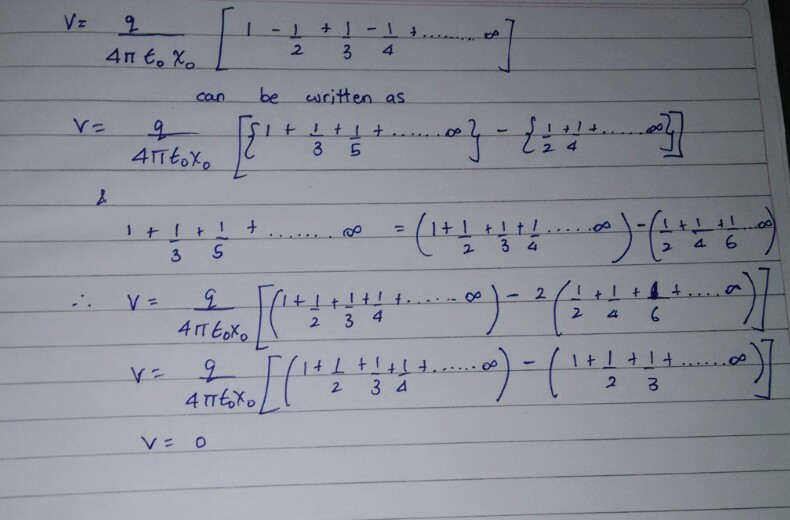Mathematical Physics Dilemma
Hello everyone.
I came across a physics question as follows,
A set of positive point charges are kept at the points on the x-axis, such that
\(x=x_{0}\),\(x=3x_{0}\),\(x=5x_{0}\)........\(\infty\)
And a set of negative point charges are placed on the x-axis, such that,
,,........
If the magnitude of the positive point charge is and the magnitude of the negative point charge is , assuming is the absolute permittivity of free space, then prove that the electric potential at the origin is
This is how I proved it.
We know by the definition of electric potential due to a point charge,
where is the separation between the origin and the point where the point charge is placed. Also it is known that the electric potential due to a system of point charges is the algebraic sum of the electric potentials due to the individual point charges.
Hence by applying this to every single point charge given, we get
Factoring out , we get
We know that the infinite summation in the square brackets is the Maclaurin's series expansion of where
Thus we get,
But instead of substituting for the logarithm expansion if we did as I have done in the attached picture, then we get answer as zero. Please tell me where I have gone wrong.

Easy Math Editor
This discussion board is a place to discuss our Daily Challenges and the math and science related to those challenges. Explanations are more than just a solution — they should explain the steps and thinking strategies that you used to obtain the solution. Comments should further the discussion of math and science.
When posting on Brilliant:
*italics*or_italics_**bold**or__bold__paragraph 1
paragraph 2
[example link](https://brilliant.org)> This is a quote# I indented these lines # 4 spaces, and now they show # up as a code block. print "hello world"\(...\)or\[...\]to ensure proper formatting.2 \times 32^{34}a_{i-1}\frac{2}{3}\sqrt{2}\sum_{i=1}^3\sin \theta\boxed{123}Comments
First of all, you cannot apply the Maclaurin's series of ln(1+x) outside its radius of convergence, which is −1<x<1.
There are, however, other methods to show that ln2=k=1∑∞k(−1)k+1
Your mistake comes from the subtraction of two divergent series as, k=1∑∞k1 does not converge!
Log in to reply
Okay now I get it. Thank you so much
Log in to reply
Actually, if you change the order of summation for non-absolutely converging series, the sum changes. In fact, by a suitable rearangement of terms, the summation given above can be made equal to any real number. Plus, the Maclaurin's series of ln(1+x) has the following domain: (−1,1]
And secondly when you rearrange the order of the terms of a series that goes to infinite you are changing the value of the sum